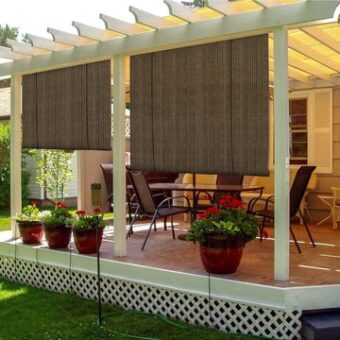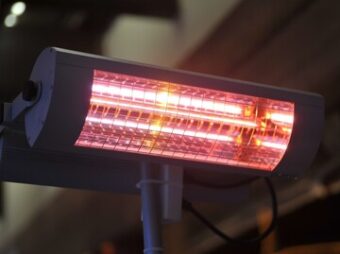Using an infrared heater for warming your patio & garden outdoor space is an excellent step toward getting the most out of that space. Infrared heat is a more sustainable and efficient heating solution when you can not contain the air within the space. However, with the abundant selection of heating options available, it can easily become overwhelming.
Outdoor electric infrared heaters come with numerous benefits. For one, they require low-maintenance operation. Even non-electric heaters require simple upkeep, such as checking obstructions in a gas line, clearing the burner area of insects, preventing leaks of gas connections, and so on. All that is great, but how do you size an outdoor heater?
Sizing an outdoor infrared heater is based on the wattage, temperature rise, and square feet of area. About 2 watts/ square foot/ temperature rise desired for comfort spot heating. We have found heating a smaller area is the best way to reduce the wattage demands.
What do we mean by smaller area to be heated…Well, say you have a 12ft x 15ft pergola and heating the whole area on a 45 degrees F (7C) would require 7200 watts of electric infrared quartz tube heaters. This would mean 2 to 3- 220V heaters, or 5- 115V 1500W heaters. This requires 45 to 70 Amps of electric service. Therefore only heating over a table, or sitting area makes sense.
What Can Reduce The Electric Demand When Heating Outside?
Reducing the heated size area to be say 8ft x 8ft from our example above then we have reduced the Amp load requirements 15 to 30 Amps. If you think about it, there isn’t really any need to heat an area you are not sitting in.
Another way to reduce your wattage demand is by reducing your expected temperature rise. Trying to make it feel like a 60 degree night when it is 45 degrees out is easier (less energy demanding) than trying to make it feel like 70 degrees. In other words reducing your expected temperature rise to 15 from 25 degrees in this sitting area example, reduces a need for 1280 Watts.
Yet, another way, is to block the breeze from carrying the air away. How do you cool hot coffee? typically you blow over the top, right? Well, even the slightest breeze will allow the the heat to dissipate from the surfaces of what the heaters are heating. So, setting up blocking screens or even plants to reduce the amount of breeze will assist in making it feel warmer.
Here is a link of all the different blocking screens available on Amazon, click here.

Is It Difficult To Size Your Own Heater?
No, following the outline below will guide you to sizing something you can enjoy for years.
These heating appliances also come in attractive designs to provide more ambiance and elegance to your outdoor space. These heaters also have a durable build. Most of them are made with resin tops and high-grade stainless steel for durability.
Moreover, patio heaters provide radiant heat, which, like the sun, uses invisible waves that infuse people and surrounding objects with warmth. Once absorbed, this radiant heat is retained to keep the surroundings warmer. Furthermore, this heat is silent and quiet, so it does not drown out music or conversations.

How to Size an Infrared Patio Heater for an Outdoor Patio
You need to find the patio infrared patio heater’s right size for your outdoor patio for the best heating performance. Here’s what to consider when choosing the correctly sized infrared heater for your outdoor space.
How big is the area to be heated?
As obvious as the answer may seem, it is still a crucial factor worth considering. Maybe you intend to heat your outdoor patio, and therefore require an infrared heater to heat the entire area. But it can get more superficial. Perhaps there is a specific area in your deck that you want to keep warm.
For instance, instead of heating the entire patio, you may opt to only heating the outdoor seating area. Focusing on this area will provide sufficient warmth without wasting energy and cutting down on your heating bills.
In other words, if your outdoor patio is 129 Feet squared (12m squared) and the seating area is only 64 ft squared (6m squared), it will not only be cheaper but also easier to heat only the seating area. You can choose an ideal infrared heater from a wide range of sleek and well-designed available heaters.
Heating an exposed patio
Firstly, yes, you can heat an exposed patio. This is owing to the versatile nature of the infrared heaters. It does allow you to heat any space, be it small or big, exposed or sheltered, and so on. Finding the right heater for you is what we are after here though.
It naturally does take a more robust heater for a more exposed area to warm up. This can be easily explained as increased air circulation drives the warm air from the desired location. But this exposed area is less important when focusing on the style of heater. Near radiation quartz heater are specially designed for exposed patios and garden areas.
Therefore, quartz heaters provide more substantial heat and are the perfect solution for those with exposed patios. These heaters will give enough warmth for you despite any weather conditions. Some options are also suitable for the larger and more sheltered spaces, such as enclosed terraces or verandas. With infrared heating, nobody is left out!
However, as we touched on above, there is a benefit if you are able to add a wind or privacy screen.
Strong heating vs. gentle all-day heat

Deciding on which type of heat you want for your outdoor space is critical. Infrared heaters primarily come in two different kinds; those that use far-infrared radiation and those using near-infrared radiation.
Near-infrared heaters work to produce shorter wavelength radiation, which in turn provides reasonably intense heat. The heat produced is ideal for quickly warming people up in exposed conditions. It may, however, get too uncomfortable when you sit under for a long time. Moreover, this heater is ideal for spot heating and providing quick warmth at the touch of a button. This function may not be possible with other style heaters.
The latter (far-infrared), on the other hand, is designed to produce a longer wavelength of infrared radiation. This heats far more gentle and is perfect for long periods like in outdoor seating areas with sheltering. Furthermore, this heater is ideal for both commercial and domestic outdoor spaces.
You can easily enjoy a meal while appreciating the pleasant warmth. However, these heaters may not work as effectively when placed in windy, breezy areas. You are therefore have a decision on what your outdoor space is; an area that needs short wave infrared, or an area that needs long wave infrared.
Positioning your outdoor heater
The outdoor heaters’ properties will vary depending on the method of installation. Some infrared heaters can either be installed indoors or outdoors and will therefore heat different sized areas.
Outside areas will technically require a more robust heating technology due to the increased airflow and lack of insulation compared to the inside spaces. For instance, some infrared heaters can heat an area of 96 sq ft (9m squared) when outside and 193 sq ft (18m squared) inside.

Additionally, if it is mounted near the ground, it produces a more concentrated infrared radiation effect that results in a more substantial and cozier heat. Some heaters can therefore provide powerful warmth over a small area when mounted close to the desired location.
When mounted farther away, they provide a gentler heat for larger spaces. This conveniently gives you a different range of options and more freedom when deciding on your heating solutions for an outdoor patio.
Typically mounting a near wave heater father away makes it more comfortable for sitting areas. A long wave infrared can be mounted in lower ceilings areas.
Choosing the ideal patio heater
Even when you narrow down to the shape, model, and size of the infrared heaters, you are still faced with a wide range of options- which can be quite daunting. With this in mind, we are here to help you find the ideal heater for your outdoor patio.
The specification tab for every product is made available for a good reason. You need to pay close attention to this tab to help you ultimately choose the perfect heater. The specifications provide sufficient detail of the heating areas both indoors and outdoors.
The big things to keep in mind here would be Voltage required, and Angle of mount.
BTU Output
Most of the patio heaters use the British Thermal Units (BTUs) or Watts as a heating power unit. Generally electrical infrared heaters use Watts. Besides this, some of the models list the heating area in feet alongside the unit. The heater with a higher number of watts or BTUs gives off more heat.
The heat output of your outdoor patio should be on the higher side, or rather always round up. Otherwise, you will need more heaters to cover an area. However, you may need more than one heater when using electric infrared heaters due to the Amp load constraints of the wiring and voltage available.
Expectedly, gas powered infrared heaters are measured in BTUs and electric are measured in Watts. Here is a little table that shows your expected output based on your input.
Safety
Safety is always a crucial factor as you do not want to put your life or property in danger even as you size your infrared heater to suit your outdoor patio or garden. During placement, you need to ensure the heater is not close to objects, so they do not catch fire. The heater needs to be placed at least at a 3-foot radius from anything flammable or that can be damaged from heat.
Another thing is to ensure the heater is securely placed, so it does not topple over. Any time you are operating the patio, you need to heed to the manufacturer’s instruction. Moreover, never leave the patio heater running unattended.
Location of Your Infrared Patio & Garden Heater
Limited outdoor use
There is a wide range of infrared patio heaters designed for use outdoors only. Also, some infrared patio heaters are applicable in the semi-outdoor spaces such as covered porches. Make sure you have that figured out if you are fully covered or partially covered.
Level surfaces
Infrared patio heaters should be placed on level surfaces if on stands.
Obstructions
Another thing is, infrared patio heaters should not be placed near plants that can easily catch fire, tree branches that are hanging low.
Clearance
you need to check the permissions to combustibles as well as the wall clearances that are offers offered by manufacturers of these units. This information is usually provided in the owners’ manual. In general back clearance on a ceiling mount is dependent on the angle, but typically: 3″ to 6″. Side walls: are typically 18″ or so. Ceiling is dependent on the angle, but if angled down it is: 3″ to 6″
Clothing
You are advised not to hang any clothing or flammable materials near or on the patio heater. Like to try and dry them.
General maintenance
Before beginning any maintenance, you are required to turn the heater off. This means unplug it, or turn the breaker in the off position. For gas heaters you would need to turn the supply off, which would mean a shut off for natural gas, and the tank for propane.
Design options
Infrared patio heaters come in a wide variety of designs. For instance, the floor-standing ones are a popular option and one of the most common types. These heaters are usually thin, tall, and give off the right amount of heat. This heater is ideal for coffee shops or restaurants with patios. There are also hanging and wall-mounted heaters in the same size and larger.
These are the go-for option for those who want to save some floor space on their outdoor patios. They, therefore, work to release sufficient heat and keep you warm while saving you floor space. Tabletop heaters are the smallest types and also heat a limited area. They are also an affordable option for those who intend to heat only the dining area.


